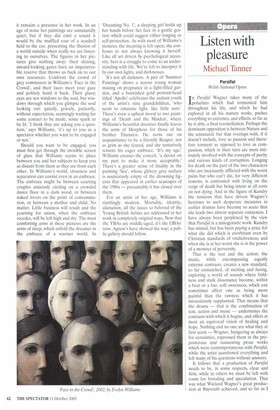Distant approach
Laura Gascoigne
Evelyn Williams: Recent Paintings Agnew's, 43 Old Bond Street, London, WI, until 17 October Uor a culture so cushioned from the 1 reality of death, we make an awful lot of art about it. Mortality as a theme is as 'in' today as it was in 17th-century Holland; then, vanitas painters knocked out skulls and dead birds for wealthy merchants, now Quinn and Hirst turn out blood heads and flayed cows for millionaire admen. It seems that in periods of prosperity it amuses the rich to collect such obvious reminders of mortality. Qua lifestyle accessory, they project the flattering image 'I may be rolling in it, but I'm philosophical'. Qua memento mori, they are mere Post-it notes compared to the paintings of Evelyn Williams.
Now in her early seventies and enjoying her first West End show at Agnew's, Williams might be surprised at the suggestion that her work is about death. Ostensibly it's about life, in all its stages. In a 40-year career that began with a bang with her winning the John Moores Prize for sculpture in 1961, Williams's muted but surprisingly large reliefs and paintings have followed her personal, often painful progress through life as a child, lover, mother and grandmother. If not strictly about death, her work is concerned with the small separations that serve as constant reminders of the big one, forming a record of one woman's lifelong struggle to close the gap between herself and others. It is quiet and unquiet work, hard to place — too intimate for the public space, too demanding for the private — but made easy on the eye by the softness of its gestures and the cool clarity of its palette, like a pebbled beach.
Williams was brought up by the sea and it remains a presence in her work. In an age of noise her paintings are unnaturally quiet, but if they did emit a sound it would be the muffled roar of a seashell held to the ear, presenting the illusion of a world outside when really we are listening to ourselves. The figures in her pictures give nothing away: their shining, inward-looking gazes have an impenetrable reserve that throws us back on to our own resources. Confront the crowd of grey commuters in Williams's 'Face in the Crowd', and their faces meet your gaze and politely hand it back. Their glassy eyes are not windows to the soul, but windows through which you glimpse the soul looking out: quietly, gravely, patiently, without expectation, seemingly waiting for some contact to be made, some spark to be lit. 'I think they are asking you a question,' says Williams, 'it's up to you as a spectator whether you want to be engaged or not.'
Should you want to be engaged, you must first get through the invisible screen of glass that Williams seems to place between you and her subjects to keep you as distant from them as they are from each other. In Williams's world, closeness and separation can coexist even in an embrace. The embrace might be between courting couples anxiously circling on a crowded dance floor in a dark wood, or between naked lovers on the point of consummation, or between a mother and child. No matter. Little business will result and the yearning for union, when the embrace recedes, will be left high and dry. The most comforting arms in these pictures are the arms of sleep, which enfold the dreamer in the embrace of a warmer world. In 'Dreaming No. 1', a sleeping girl holds up her hands before her face in a gentle gesture which could suggest either longing or self-protection. As with most of Williams's pictures, the meaning is left open; she confesses to not always knowing it herself. Like all art driven by psychological necessity, hers is a struggle to come to an understanding with life. We're left to interpret it by our own lights, and darknesses.
It's not all darkness. A pair of 'Summer Paintings' shows a serene young woman musing on pregnancy in a light-filled garden, and a burnished gold portrait-head titled 'Apollo' celebrates the radiant youth of the artist's nine grandchildren, 'who seem to emanate light, like little suns'. There's even a upbeat mood to two paintings of 'Death and the Maiden', where Williams's beautiful dreamer finally leaves the arms of Morpheus for those of his brother Thanatos. He turns out on acquaintance to be a friendly Reaper, not as grim as she feared, and she tentatively returns his eager embrace. 'It's my age,' Williams excuses the conceit, 'a device on my part to make it more acceptable.' There's a greater sense of finality in the painting 'Sea', whose glittery grey surface is suspiciously empty of the drowning figures that appeared in earlier seascapes of the 1980s — presumably it has closed over them.
For an artist of her age, Williams is startlingly modern. Mortality, identity, alienation, all the issues so beloved of the Young British Artists are addressed in her work in completely original ways. Now that the YBAs are middle-aged, it's the OBAs' turn. Agnew's have showed the way; a public gallery should follow.



















































































 Previous page
Previous page